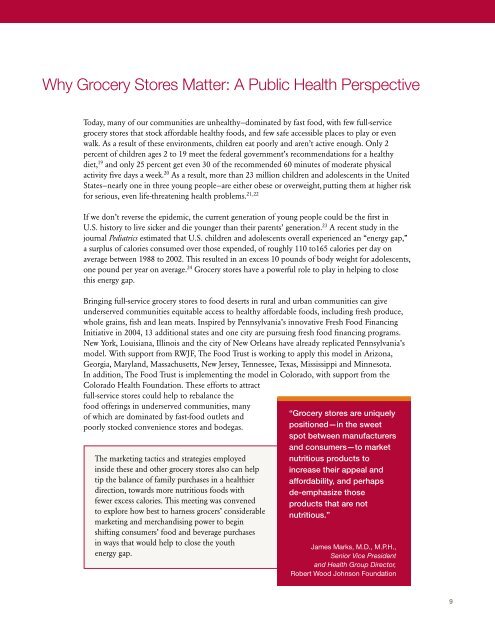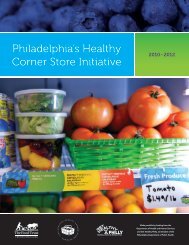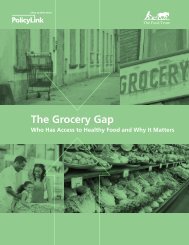Harnessing the Power of Supermarkets to Help ... - The Food Trust
Harnessing the Power of Supermarkets to Help ... - The Food Trust
Harnessing the Power of Supermarkets to Help ... - The Food Trust
Create successful ePaper yourself
Turn your PDF publications into a flip-book with our unique Google optimized e-Paper software.
Why Grocery S<strong>to</strong>res Matter: A Public Health Perspective<br />
Today, many <strong>of</strong> our communities are unhealthy—dominated by fast food, with few full-service<br />
grocery s<strong>to</strong>res that s<strong>to</strong>ck affordable healthy foods, and few safe accessible places <strong>to</strong> play or even<br />
walk. As a result <strong>of</strong> <strong>the</strong>se environments, children eat poorly and aren’t active enough. Only 2<br />
percent <strong>of</strong> children ages 2 <strong>to</strong> 19 meet <strong>the</strong> federal government’s recommendations for a healthy<br />
diet, 19 and only 25 percent get even 30 <strong>of</strong> <strong>the</strong> recommended 60 minutes <strong>of</strong> moderate physical<br />
activity five days a week. 20 As a result, more than 23 million children and adolescents in <strong>the</strong> United<br />
States—nearly one in three young people—are ei<strong>the</strong>r obese or overweight, putting <strong>the</strong>m at higher risk<br />
21, 22<br />
for serious, even life-threatening health problems.<br />
If we don’t reverse <strong>the</strong> epidemic, <strong>the</strong> current generation <strong>of</strong> young people could be <strong>the</strong> first in<br />
U.S. his<strong>to</strong>ry <strong>to</strong> live sicker and die younger than <strong>the</strong>ir parents’ generation. 23 A recent study in <strong>the</strong><br />
journal Pediatrics estimated that U.S. children and adolescents overall experienced an “energy gap,”<br />
a surplus <strong>of</strong> calories consumed over those expended, <strong>of</strong> roughly 110 <strong>to</strong>165 calories per day on<br />
average between 1988 <strong>to</strong> 2002. This resulted in an excess 10 pounds <strong>of</strong> body weight for adolescents,<br />
one pound per year on average. 24 Grocery s<strong>to</strong>res have a powerful role <strong>to</strong> play in helping <strong>to</strong> close<br />
this energy gap.<br />
Bringing full-service grocery s<strong>to</strong>res <strong>to</strong> food deserts in rural and urban communities can give<br />
underserved communities equitable access <strong>to</strong> healthy affordable foods, including fresh produce,<br />
whole grains, fish and lean meats. Inspired by Pennsylvania’s innovative Fresh <strong>Food</strong> Financing<br />
Initiative in 2004, 13 additional states and one city are pursuing fresh food financing programs.<br />
New York, Louisiana, Illinois and <strong>the</strong> city <strong>of</strong> New Orleans have already replicated Pennsylvania’s<br />
model. With support from RWJF, <strong>The</strong> <strong>Food</strong> <strong>Trust</strong> is working <strong>to</strong> apply this model in Arizona,<br />
Georgia, Maryland, Massachusetts, New Jersey, Tennessee, Texas, Mississippi and Minnesota.<br />
In addition, <strong>The</strong> <strong>Food</strong> <strong>Trust</strong> is implementing <strong>the</strong> model in Colorado, with support from <strong>the</strong><br />
Colorado Health Foundation. <strong>The</strong>se efforts <strong>to</strong> attract<br />
full-service s<strong>to</strong>res could help <strong>to</strong> rebalance <strong>the</strong><br />
food <strong>of</strong>ferings in underserved communities, many<br />
<strong>of</strong> which are dominated by fast-food outlets and<br />
poorly s<strong>to</strong>cked convenience s<strong>to</strong>res and bodegas.<br />
<strong>The</strong> marketing tactics and strategies employed<br />
inside <strong>the</strong>se and o<strong>the</strong>r grocery s<strong>to</strong>res also can help<br />
tip <strong>the</strong> balance <strong>of</strong> family purchases in a healthier<br />
direction, <strong>to</strong>wards more nutritious foods with<br />
fewer excess calories. This meeting was convened<br />
<strong>to</strong> explore how best <strong>to</strong> harness grocers’ considerable<br />
marketing and merchandising power <strong>to</strong> begin<br />
shifting consumers’ food and beverage purchases<br />
in ways that would help <strong>to</strong> close <strong>the</strong> youth<br />
energy gap.<br />
“Grocery s<strong>to</strong>res are uniquely<br />
positioned—in <strong>the</strong> sweet<br />
spot between manufacturers<br />
and consumers—<strong>to</strong> market<br />
nutritious products <strong>to</strong><br />
increase <strong>the</strong>ir appeal and<br />
affordability, and perhaps<br />
de-emphasize those<br />
products that are not<br />
nutritious.”<br />
James Marks, M.D., M.P.H.,<br />
Senior Vice President<br />
and Health Group Direc<strong>to</strong>r,<br />
Robert Wood Johnson Foundation<br />
9






